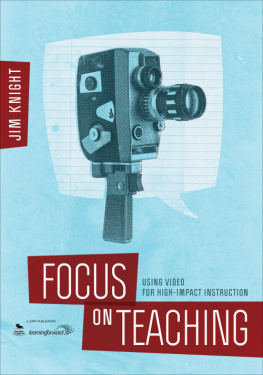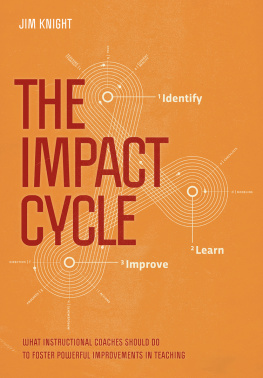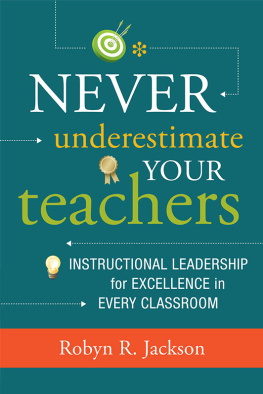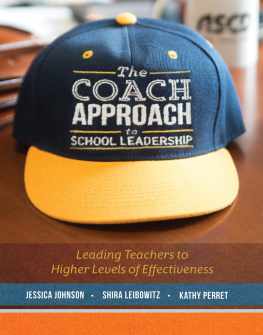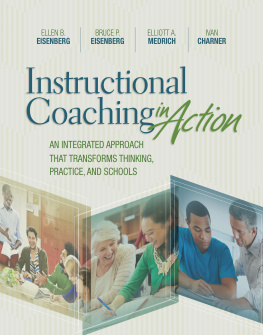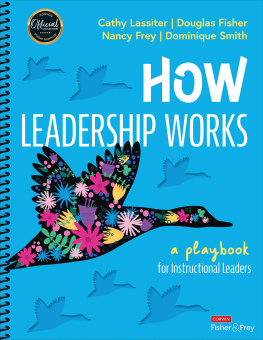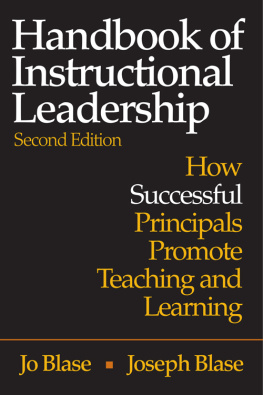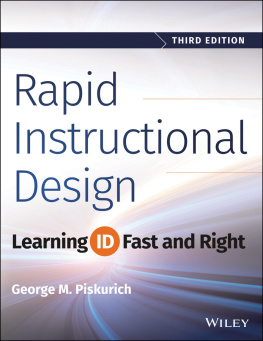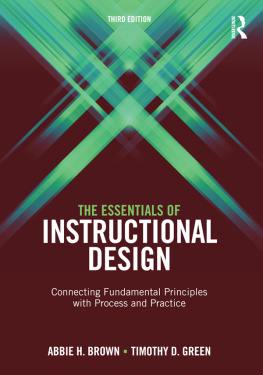Instructional
COACHES
and the
Instructional
LEADERSHIP TEAM
We would like to dedicate this book to our families for supporting us along the way and to the great instructional coaches that we have worked with over the years. D. T. S. & G. S.
Instructional
COACHES
and the
Instructional
LEADERSHIP TEAM
A Guide for School-Building Improvement
DEAN T. SPAULDING
GAIL SMITH


FOR INFORMATION:
Corwin
A SAGE Company
2455 Teller Road
Thousand Oaks, California 91320
(800) 233-9936
www.corwin.com
SAGE Publications Ltd.
1 Olivers Yard
55 City Road
London, EC1Y 1SP
United Kingdom
SAGE Publications India Pvt. Ltd.
B 1/I 1 Mohan Cooperative Industrial Area
Mathura Road, New Delhi
India 110 044
SAGE Publications Asia-Pacific Pte. Ltd.
3 Church Street
#10-04 Samsung Hub
Singapore 049483
Copyright 2012 by Corwin
All rights reserved. When forms and sample documents are included, their use is authorized only by educators, local school sites, and/or noncommercial or nonprofit entities that have purchased the book. Except for that usage, no part of this book may be reproduced or utilized in any form or by any means, electronic or mechanical, including photocopying, recording, or by any information storage and retrieval system, without permission in writing from the publisher.
All trade names and trademarks recited, referenced, or reflected herein are the property of their respective owners who retain all rights thereto.
Printed in the United States of America.
A catalog record of this book is available from the Library of Congress.
978-1-4522-2638-5
This book is printed on acid-free paper.
12 13 14 15 16 10 9 8 7 6 5 4 3 2 1
Acquisitions Editor: Arnis Burvikovs
Associate Editor: Desire A. Bartlett
Editorial Assistant: Kimberly Greenberg
Project Editor: Cassandra Margaret Seibel
Copy Editor: Erin Livingston
Typesetter: Hurix Systems Pvt. Ltd.
Proofreader: Susan Schon
Indexer: Jean Casalegno
Cover Designer: Michael Dubowe
Permissions Editor: Karen Ehrmann
Contents
Preface
I f you are a district administrator, principal, or school leader and want to improve the quality of instruction in each and every classroom, where do you begin? You begin with this book. This book will provide you and your Instructional Leadership Team (ILT) with a step-by-step guide to improve each and every one of your teachers by using the talent and expertise from within your own learning community. Imagine improving the academic achievement of your students at no additional expense! All you have to do is recognize and identify the endless amount of talent and expertise you already have in your building through the use of instructional coaches.
Each chapter of this book not only provides school leaders with important information on how to go about implementing instructional coaching but also provides materials to help with the step-by-step implementation process. At the end of each chapter you will find Self-Study Activities and data collection forms and instruments to be used by school leaders and instructional coaches. These forms have already been field-tested and will allow you and your staff to seamlessly collect the vital data and conduct the day-to-day activities to maximize the effect of your buildings instructional coaches.
In addition to end-of-chapter materials, you will also find a wide variety of materials and instruments at the end of the book. These too have been field-tested and designed by instructional coaches for collecting various forms of formative and summative data to improve classroom practice and student achievement. In a time when school buildings are being closed and teachers terminated for poor student performance, the need for high-quality classroom instruction has never been greater. However, how a school goes about improving instruction is an entirely different matter altogether. Traditionally, improving classroom instruction has been left up to the building principal. Principals have typically addressed this need by conducting classroom observations, giving staff formative feedback, and providing professional development opportunities; however, a principals ability to visit classrooms is quickly diminished by the vast numbers of noninstructional issues he or she has to deal with on a daily basis. These noninstructional issues severely limit the amount of time and impact a principal can have on instruction in the classroom. In many cases, this lack of administrative presence has created a gap in trying to improve classroom instruction, particularly in low-performing schools. In order to address this gap, many schools have turned to employing instructional coaches.
WHAT IS AN INSTRUCTIONAL COACH?
An instructional coach (IC) is an on-site professional developer who works directly with teachers and staff on how to go about implementing research or evidence-based strategies and techniques into their everyday classrooms. While instructional coaches may sound similar to literacy coaches, the instructional coach takes a more generalist approach, many times working with teachers one-on-one on a wide variety of content from mathematics to science. A successful instructional coach is a unique individual. They must be skilled in a variety of roles. They have to be a public relations guru, a communicator extraordinaire, a master organizer, and, of course, an expert educator.
USING AN INSTRUCTIONAL LEADERSHIP TEAM APPROACH
Even though they may have an IC in the building, many schools find that they dont necessarily make the gains in student achievement they were expecting. Research suggests that when it comes to using an IC, many ICs unfortunately fall victim to the same distractions that keep many principals out of the classrooms. In order to gain the most impact from having an IC in your building, a larger team effort has been recommended. The role of the school principal and teaching staff is critical in providing the ideal environment for instructional coaches to work and be successful. This team approach is often referred to as the Instructional Leadership Team or ILT. The purpose of this book is to provide a guide or framework for the school principal, staff, and the instructional coach to create a more effective environment for the instructional coach to work in and be successful.
OUR RESEARCH WITH INSTRUCTIONAL COACHES
For the last fifteen years, we have been working with ICs in one form or another. Many of our research and evaluation projects incorporate some aspect of ICs to improve classroom instruction and ultimately increase student achievement. Most recently, we have conducted a study of 13 instructional coaches in low-performing elementary school buildings and worked with the ICs to provide technical assistance as well as to document day-to-day progression and professional growth of these instructional coaches and the teachers they worked with. All of this research has formed the foundation for this book, allowing it to take on a unique approach that separates it from other instructional coaching books currently on the market. This book is different from other books on the market because it recognizes the importance of the school community: the building principal, the school staff, and the instructional coach. Using a journaling approach, the book provides the point-of-view of all three of these stakeholders and therefore can be read and enjoyed by all members of the school community. This dialogue is critical in showing the different perspectives, their views of instructional coaching, and how such a good idea can oftentimes be derailed.
Next page


